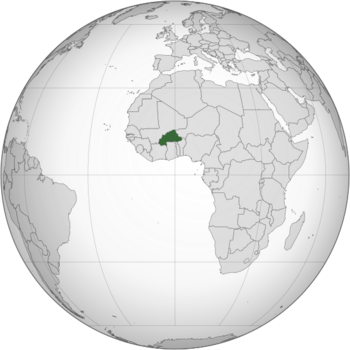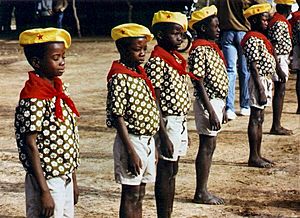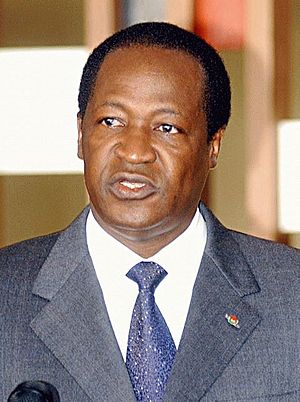History of Burkina Faso facts for kids
The history of Burkina Faso tells the story of different kingdoms that existed in the country, like the Mossi Kingdoms. It also covers the time when France ruled the land, and how it later became independent as the Republic of Upper Volta in 1960.
Contents
Ancient and medieval times
People started making iron in areas near Douroula as early as 800 BC. By 500 BC, this skill was common across the region. Old furnaces, mines, and homes from this period can be found all over the country.
Recent discoveries at Bura in Niger and nearby Burkina Faso show that the Bura culture existed from the 3rd to the 13th century. This culture was part of the Iron Age. More research is needed to understand how important this early civilization was in the history of West Africa.
Loropéni is an ancient stone ruin. It was important for the gold trade between the 14th and 17th centuries. Today, it is a World Heritage Site.
From the Middle Ages until the late 1800s, the central part of what is now Burkina Faso was ruled by the Mossi people. These people were descendants of warriors from the Dagomba kingdom in Ghana. They mixed with Mandé and other local groups around the 11th century. During this time, the Mossi Kingdoms successfully protected their land, their religious beliefs, and their way of life. They fought off attempts by their Muslim neighbors to conquer them and force them to change their religion.
French Upper Volta
France arrived and claimed the area in 1896. However, the Mossi people resisted until their capital, Ouagadougou, was captured in 1901. In 1919, some areas from Ivory Coast were joined together to form French Upper Volta. This was part of the larger French West Africa federation.
In 1932, the new colony was split up for economic reasons. It was put back together in 1937 as an administrative area called the Upper Coast. After World War II, the Mossi people strongly pushed France to make Upper Volta a separate territory again. On September 4, 1947, Upper Volta became a French West African territory once more.
Changes to how French Overseas Territories were organized began in 1956. These changes gave the territories more self-government. Upper Volta became an independent republic within the French community on December 11, 1958. On July 11, 1960, France agreed that Upper Volta would become fully independent.
Republic of Upper Volta
The Republic of Upper Volta became independent on August 5, 1960. The first president was Maurice Yaméogo. He was the leader of the Voltaic Democratic Union (UDV) party. The 1960 constitution said that the president and national assembly would be elected every five years.
Soon after becoming president, Yaméogo banned all political parties except his own. Many people thought Yaméogo's government was corrupt. They also believed it continued to favor French political and economic interests. This allowed politicians to get rich, but not the country's farmers or city workers.
His government lasted until 1966. After many protests, including large demonstrations and strikes by students, workers, and government employees, the military stepped in. They removed Yaméogo from power in the 1966 Upper Voltan coup d'état. The military leaders stopped the constitution and closed the National Assembly. Lieutenant Colonel Sangoulé Lamizana was put in charge of a government made up of senior army officers.
The army stayed in power for four years. On June 14, 1970, the people of Upper Volta approved a new constitution. This constitution set up a four-year period to return to full civilian rule. Lamizana remained president throughout the 1970s, leading military or mixed civilian-military governments. He faced a big problem with the Sahel drought in 1973. He traveled to the UN and the US to get help.
After disagreements about the 1970 constitution, a new one was written and approved in 1977. Lamizana was reelected in open elections in 1978.
Lamizana's government had problems with the country's powerful trade unions. On November 25, 1980, Colonel Saye Zerbo overthrew President Lamizana in a peaceful coup. Colonel Zerbo created the Military Committee of Recovery for National Progress. This committee became the highest government authority, ending the 1977 constitution.
Colonel Zerbo also faced resistance from trade unions. He was overthrown two years later, on November 7, 1982. Major Dr. Jean-Baptiste Ouédraogo and the Council of Popular Salvation (CSP) took over. The CSP continued to ban political parties. However, they promised to return to civilian rule and create a new constitution.
Disagreements grew between different groups within the CSP. The leader of one group, Captain Thomas Sankara, was made prime minister in January 1983. But he was later arrested. Efforts to free him, led by Captain Blaise Compaoré, resulted in a military coup on August 4, 1983.
This coup brought Sankara to power. His government started many revolutionary programs. These included large-scale vaccinations, improving roads and buildings, expanding women's rights, encouraging local farming, and projects to stop the desert from spreading.
Burkina Faso
Quick facts for kids
Burkina Faso
|
|||||||||
|---|---|---|---|---|---|---|---|---|---|
| 1983–1987 | |||||||||
|
Anthem: Une Seule Nuit / Ditanyè
(English: "One Single Night / Hymn to Victory") |
|||||||||
 |
|||||||||
| Capital | Ouagadougou | ||||||||
| Government | Unitary Sankarist republic under a benevolent military dictatorship/junta | ||||||||
| President | |||||||||
|
• 1983 - 1987
|
Thomas Sankara | ||||||||
| Historical era | Cold War | ||||||||
|
• Established
|
4 August 1983 | ||||||||
|
• Renamed to Burkina Faso
|
2 August 1984 | ||||||||
|
• Agacher Strip War
|
25 December 1985 | ||||||||
|
• 1987 Coup d'état
|
15 October 1987 | ||||||||
| Area | |||||||||
|
• Total
|
274,200 km2 (105,900 sq mi) | ||||||||
| Currency | West African CFA franc (XOF) | ||||||||
|
|||||||||
On August 2, 1984, President Sankara changed the country's name from Upper Volta to Burkina Faso. This name means "land of the upright/honest people." The National Assembly confirmed this change on August 4.
Sankara's government created the National Council for the Revolution (CNR). Sankara was its president. They also set up local groups called Committees for the Defense of the Revolution (CDRs). A youth program called the Pioneers of the Revolution was also started.
Sankara began a huge plan for social and economic change. It was one of the biggest ever in Africa. His foreign policies focused on being against imperialism. His government refused all foreign aid. They pushed for reducing unfair national debts. They also took control of all land and minerals for the country. This helped them avoid the power of the International Monetary Fund (IMF) and World Bank.
His policies inside the country included a national campaign to teach people to read and write. He also gave land to farmers. He built railways and roads. He made forced marriages and polygamy (having more than one spouse) illegal.
Sankara wanted the country to grow enough food for itself. He also promoted public health. He vaccinated 2.5 million children against meningitis, yellow fever, and measles. His national plan also included planting over 10 million trees to stop the desertification of the Sahel region. Sankara asked every village to build a medical clinic. Over 350 communities built schools using their own labor.
Five-day War with Mali
On Christmas Day 1985, tensions with Mali led to a war. The conflict was over the Agacher Strip, an area rich in minerals. The war lasted five days and killed about 100 people. The conflict ended after President Félix Houphouët-Boigny of Ivory Coast helped mediate. In Burkina Faso, this conflict is known as the "Christmas war."
Many of the strict measures Sankara took faced growing resistance. Despite his popularity, problems began to appear in how his revolutionary ideas were put into practice.
Rule of Blaise Compaoré
|
Burkina Faso
|
|||||||||
|---|---|---|---|---|---|---|---|---|---|
| 1987–2014 | |||||||||
|
Anthem: Une Suele Nuit / Ditanyè
(English: "One Single Night / Hymn to Victory") |
|||||||||
 |
|||||||||
| Capital | Ouagadougou | ||||||||
| Government | Unitary dominant-party republic under a dictatorship | ||||||||
| President | |||||||||
|
• 1987 - 2014
|
Blaise Compaoré | ||||||||
| Prime Minister | |||||||||
|
• 1992–1994 (first)
|
Youssouf Ouédraogo | ||||||||
|
• 2011–2014 (last)
|
Luc-Adolphe Tiao | ||||||||
| History | |||||||||
|
• 1987 Coup d'état
|
15 October 1987 | ||||||||
|
• 2014 Burkina Faso uprising
|
28 October - 3 November 2014 | ||||||||
| Area | |||||||||
|
• Total
|
274,200 km2 (105,900 sq mi) | ||||||||
| Currency | West African CFA franc (XOF) | ||||||||
|
|||||||||
The CDRs, which were meant to be groups for ordinary people, sometimes became like armed gangs in some areas. They clashed with several trade unions. Tensions grew steadily over the government's harsh methods and its overall direction. On October 15, 1987, Sankara was killed in a coup. This brought Captain Blaise Compaoré to power.
Compaoré, Captain Henri Zongo, and Major Jean-Baptiste Boukary Lengani formed the Popular Front (FP). They promised to continue the goals of the revolution. They also said they would "correct" Sankara's "mistakes." The new government quietly changed many of Sankara's policies to gain support from business owners. As part of a political "opening," several political groups, including some that were not Marxist, joined an umbrella organization created by the FP in June 1989.
Some members of a leftist group, the Organisation pour la Démocratie Populaire/Mouvement du Travail (ODP/MT), were against allowing non-Marxist groups into the front. On September 18, 1989, while Compaoré was returning from a trip, Lengani and Zongo were accused of plotting to overthrow the Popular Front. They were arrested and executed the same night. Compaoré reorganized the government, appointed new ministers, and took on the role of Minister of Defense and Security. On December 23, 1989, presidential security arrested about 30 civilians and military personnel. They were accused of plotting a coup with opposition groups outside Burkina Faso.
Burkina Faso adopted a new constitution on June 2, 1991.
In 2005, Compaoré was elected for his third term. In November 2010, President Compaoré was re-elected for a fourth term. He won 80.2% of the votes. Hama Arba Diallo came in a distant second with 8.2%.
In February 2011, the death of a schoolboy caused protests across the country. These protests lasted until April 2011. There was also a military mutiny and a strike by judges.
Overthrow of Compaoré
In June 2014, Compaoré's ruling party, the CDP, asked him to hold a referendum. This would allow him to change the constitution so he could run for re-election in 2015. Otherwise, he would have to step down because of term limits.
On October 30, 2014, the National Assembly was supposed to discuss a change to the constitution. This change would have allowed Compaoré to run for president again in 2015. Opponents protested by storming the parliament building in Ouagadougou. They started fires inside and looted offices. Smoke was seen coming from the building. An opposition spokesman called the protests "Burkina Faso’s black spring, like the Arab spring."
Compaoré reacted by stopping the proposed constitutional changes. He dissolved the government, declared a state of emergency, and offered to work with the opposition. Later that day, the military, led by General Honore Traore, announced that it would set up a temporary government. They said this would be done "in consultation with all parties." They also said the National Assembly was dissolved and expected "a return to the constitutional order" within a year. Compaoré said he was ready to leave office at the end of the transition.
On October 31, Compaoré announced he had left the presidency. He said there was a "power vacuum" and called for a "free and transparent" election within 90 days. Yacouba Isaac Zida then took over as interim head of state.
On November 17, 2014, a civilian named Michel Kafando was chosen to replace Zida as the temporary head of state. He was sworn in on November 18. Kafando then appointed Zida as Prime Minister of Burkina Faso on November 19, 2014.
On July 19, 2015, there were tensions between the military and Prime Minister Zida. Kafando removed Zida from his role as defense minister and took over that job himself. He also took over the security role, which Zida's ally Auguste Denise Barry had held. In the same changes, he appointed Moussa Nébié to replace himself as Minister of Foreign Affairs.
September 2015 failed coup d'état
On September 16, 2015, members of the Regiment of Presidential Security (RSP) detained President Kafando and Prime Minister Zida. This happened two days after a recommendation to break up the RSP. The RSP then put the National Council for Democracy in power, with Gilbert Diendéré as its chairman.
The military chief of staff, Brigadier General Pingrenoma Zagré, asked the RSP members to surrender their weapons. He promised they would not be harmed if they gave up peacefully.
Kafando was believed to be under house arrest until September 21. Then, he was reported to have arrived at the French ambassador's home. The regular army gave the RSP an ultimatum to surrender by the morning of September 22.
Kafando was put back in office as president at a ceremony on September 23. Leaders from ECOWAS (a West African organization) were present.
On September 25, the RSP was officially disbanded by the government. On September 26, the state prosecutor froze the money and property of Diendéré and others linked to the coup. They also froze the assets of four political parties, including the CDP. Djibril Bassolé and Eddie Komboïgo, who were not allowed to run for president, also had their assets frozen. Bassolé was arrested on September 29 for supposedly supporting the coup.
2015 general election
On October 13, 2015, it was announced that general elections would be held on November 29, 2015. The Congress for Democracy and Progress was not allowed to have a presidential candidate. However, it could still take part in the parliamentary election.
The presidential election was won by Roch Marc Christian Kaboré of the People's Movement for Progress (MPP). He received 53% of the votes in the first round, so a second round was not needed. The MPP also won the parliamentary election. They got 34.71% of the votes and won 55 seats in the National Assembly. The Union of Progress and Reform came second with 20.53% and 33 seats. The Congress for Democracy and Progress was third with 13.20% and 18 seats.
Kaboré was sworn in as president on December 29, 2015. On January 7, 2016, he appointed Paul Kaba Thieba as Prime Minister.
Burkina Faso in 2018
In 2018, Burkina Faso was described as a poor country with no access to the sea. It relies on enough rainfall for its economy. Uneven rainfall, poor soil, and a lack of good roads and other infrastructure make the economy vulnerable. About 80% of the people work in farming to feed themselves. Cotton is the main crop sold for money. The country has few natural resources and not many factories. Cotton and gold are Burkina Faso’s main exports. The country has seen more gold mining and exports.
Even though the political crisis ended, allowing the economy to grow, the country's unstable security situation could put this progress at risk. Problems in neighboring Mali, unreliable energy, and poor transportation links are long-term challenges. The country experienced terrorist attacks in its capital in 2016, 2017, and 2018. It continues to use resources to fight terrorist threats. Several governments warned their citizens not to travel to the northern and eastern parts of the country in 2018.
Burkina Faso's fast population growth, repeated droughts, constant food shortages, and limited natural resources mean poor economic chances for most of its citizens. However, there is some hope, especially with help from the International Monetary Fund. A new three-year IMF program (2018-2020) was approved in 2018. This program will help the government reduce its budget deficit. It will also keep important spending on social services and key public investments.
November 2020 election
In the 2020 general election, President Roch Marc Christian Kaboré was re-elected. However, his party, Mouvement du people MPP, did not win a full majority in parliament. It secured 56 seats out of 127. The Congress for Democracy and Progress (CDP), the party of former President Blaise Compaoré, was a distant second with 20 seats.
2022 military coups
On January 24, 2022, President Roch Kaboré was removed from power in a military coup. Lieutenant Colonel Paul-Henri Sandaogo Damiba led the Patriotic Movement for Safeguard and Restoration (MPSR). This group included all parts of the army. The MPSR announced that it had decided to end President Kabore's term. On January 31, the new military government appointed coup leader Paul-Henri Sandaogo Damiba as interim president. The African Union (AU) suspended Burkina Faso's membership.
On September 30, 2022, a second military coup took place. Damiba was removed because he could not deal with an Islamist insurgency. Captain Ibrahim Traoré took over as interim leader. President Damiba resigned and left the country. On October 6, 2022, Captain Ibrahim Traore was officially appointed as president of Burkina Faso.
See also
 In Spanish: Historia de Burkina Faso para niños
In Spanish: Historia de Burkina Faso para niños
- Ouagadougou history and timeline (capital and largest city)
- History of Africa
- History of West Africa
- List of heads of government of Burkina Faso
- List of heads of state of Burkina Faso
- Politics of Burkina Faso






